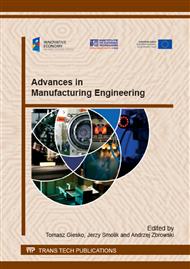p.89
p.100
p.110
p.119
p.127
p.137
p.146
p.155
p.163
The Influence of Thickness of Layers in the Multilayer Coating of the PN + AlCrTiNmultinano Hybrid Layer on Tribological Properties
Abstract:
One of the most perspective directions of the development of surface engineering is related to hybrid technologies. The best-known and widely used hybrid surface treatment technology is a combination of a gas or plasma nitriding process with the process of the deposition of hard antiwear coatings by means of PVD methods. The paper presents the influence of the thickness of layers in the multilayer coating on tribological properties of hybrid layers – PN + AlCrTiNmultinano obtained on the EN X32CrMoV3.3 hot working steel. The research methods concentrated on the analysis of mechanical properties, surface topography and microstructure, and tribological properties. The studies on mechanical properties included tests on hardness using the nanoindentation method and tests on adhesion using the scratchtest. The analysis of surface topography and microstructure was examined by scanning electron microscopy and scanning transmission electron microscopy. The tribological properties were examined using the ball-on-disc method. The coating was tested with alumina balls as counterparts at room temperature. The authors indicate that the PN + AlCrTiNmultinano hybrid layers are characterized by excellent mechanical properties and tribological resistance. In this paper, the authors confirmed that the thickness of layers in a multilayer coating is important in shaping the mechanical and tribological properties of the PN + AlCrTiNmultinano hybrid layer.
Info:
Periodical:
Pages:
127-136
Citation:
Online since:
November 2014
Price:
Сopyright:
© 2015 Trans Tech Publications Ltd. All Rights Reserved
Share:
Citation:


